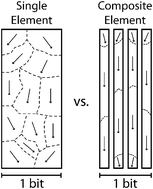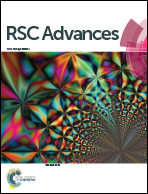A composite element bit design for magnetically encoded microcarriers for future combinatorial chemistry applications
Abstract
We present a new composite element (CE) bit design for the magnetic bit encoding of suspended microcarriers, which has significant implications for library generation applications based on microfluidic combinatorial chemistry. The CE bit design consists of high aspect ratio strips with appropriate dipolar interactions that enable a large coercivity range and the formation of up to 14 individually addressable bits (16 384 codes) with high encoding reliability. We investigate Ni80Fe20 and Co CEs, which produce coercivity ranges of 8–290 Oe and 75–172 Oe, respectively, showing significant improvements to previously proposed bit designs. By maintaining the total magnetic volume for each CE bit, the barcode design enables a consistent stray field for in-flow magnetic read-out. The CE bit design is characterised using magneto-optic Kerr effect (MOKE) measurements and the reliability of the design is demonstrated in a multi-bit encoding process capable of identifying each bit transition for every applied magnetic field pulse. By constraining each magnetic bit to have a unique switching field using the CE design, we enable sequential encoding of the barcode using external magnetic field pulses. We therefore discuss how the new CE barcode design makes magnetically encoded microcarriers more relevant for rapid and non-invasive detection, identification and sorting of compounds in biomolecular libraries, where each microcarrier is for example capable of recording its reaction history in daisy-chained microfluidic split-and-mix processes.


 Please wait while we load your content...
Please wait while we load your content...